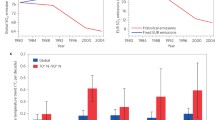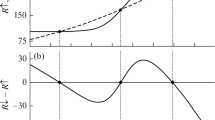Abstract
In accordance with numerous investigations, global climate warming due to the increased greenhouse gas content in the atmosphere can significantly influence the environment already in the near decades. In order to mitigate or prevent possible adverse consequences of this warming the technologies on reducing greenhouse gas emissions as well as a deliberate interference with climate, including its control, are under consideration. Let us analyze the present investigations on the estimate of the influence of a simultaneous increase in the atmospheric CO2 concentration and in the stratospheric aerosol on the global and regional climate, ozone layer, and World Ocean acidification. It is noted that the production and subsequent maintenance of the artificial aerosol layer in the stratosphere could, in principle, eliminate or retard climate warming, but it would be accompanied by a decrease in the global precipitation, especially in the tropical zone. Furthermore, the stratospheric aerosol screen does not solve the problem of the atmospheric CO2 increase, which in turn results in the further World Ocean acidification, and thus has an adverse effect on the marine part of the biosphere. Political and ethic issues connected with the deliberate global man interference with the natural environment are also under considerations.
Similar content being viewed by others
References
M. I. Budyko, “Climate Impact Method,” Meteorol. Gidrol., No. 2 (1974) [Sov. Meteorol. Gidrol., No. 2 (1974)].
Opportunities to Prevent Climate Changes and Its Consequences. The Kyoto Protocol Problems. Materials of the Council-Seminar of the Russian Academy of Sciences, Ed. by Yu. A. Izrael (Nauka, Moscow, 2006).
A. V. Eliseev and I. I. Mokhov, “Model Estimates of Efficiency of Global Climate Warming Mitigation and Prevention Depending on Scenarios for Controlling Aerosol Emissions in the Stratosphere,” Izv. Ross. Akad. Nauk, Fiz. Atmos. Okeana, No. 2, 45 (2009) [Izv., Atmos. Oceanic Phys., No. 2, 45 (2009)].
Yu. A. Izrael, “An Efficient Way to Regulate the Global Climate Is the Main Objective of the Solution of the Climate Problem,” Meteorol. Gidrol., No. 10 (2005) [Russ. Meteorol. Hydrol., No. 10 (2005)].
Yu. A. Izrael, I. I. Borzenkova, and D. A. Severov, “Role of Stratospheric Aerosols in the Maintenance of Present Day Climate,” Meteorol. Gidrol., No. 1 (2007) [Russ. Meteorol. Hydrol., No. 1, 32 (2007)].
Yu. A. Izrael, V. M. Zakharov, N. N. Petrov, et al., “Field Experiment in Studying Solar Radiation Passing through Aerosol Layer,” Meteorol. Gidrol., No. 5 (2009) [Russ. Meteorol. Hydrol., No. 5, 34 (2009)].
V. P. Meleshko, I. L. Karol, V. M. Kattsov, et al., “The Equilibrium Climate Response to Deliberate Stratospheric Aerosol Emission Calculated from the GGO Atmosphere and Upper Ocean Layer Global Model,” Trudy GGO, No. 558 (2008) [Trans. Main Geophysical Observatory, No. 558 (2008)].
Assessment Report on Climate Changes and Their Consequences in the Russian Federation. Vol. 1. Climate Change (Federal Service for Hydrometeorology and Monitoring of Natural Environment (Roshydromet), Moscow, 2008).
D. Archer, H. Khesgi, and E. Maier-Reimer, “Multiple Timescales for Neutralization of Fossil Fuel CO2,” Geophys. Res. Lett., 24 (1997).
G. Bala, P. B. Duffy, and K. E. Taylor, “Impact of Geoengineering Schemes on the Global Hydrological Cycle,” PNAS, No. 22, 105 (2008).
L. Bengtsson, “Geoengineering to Confine Climate Change: Is It at All Feasible?” Climatic Change, 77 (2006).
K. Caldeira and L. Wood, “Global and Arctic Climate Engineering: Numerical Model Studies,” Phil. Trans. Roy. Soc. London A., 366 (2008).
R. J. Cicerone, “Geoengineering: Encouraging Research and Overseeing Implementation. An Editorial Comment,” Climatic Change, 77 (2006).
Climate Change 2007: The Physical Science Basis. Contribution of Working Group I to the Fourth Assessment Report of the Intergovernmental Panel on Climate Change, Ed. by S. Solomon, D. Quin, M. Manning, et al., Cambridge University Press (Cambridge, United Kingdom and New York, NY, USA, 2007).
P. J. Crutzen, “Albedo Enhancement by Stratospheric Sulfur Injection: A Contribution to Resolve a Policy Dilemma?” Climatic Change, 77 (2006).
R. E. Dickinson, “Climate Engineering: A Review of Aerosol Approaches to Changing the Global Energy Balance,” Climatic Change, 33 (1996).
S. C. Doney, V. J. Fabry, R. A. Feely, and J. A. Kleypas, “Ocean Acidification: The Other CO2 Problem,” Annu. Rev. Marine Sci., 1 (2009).
K. Frieler, M. Meinshausen, and B. Hare, “High Noon for 2°C,” Air Clim., Environmental Fact Sheet No. 2, October (2009).
“Geoengineering the Climate. Science, Governance and Uncertainty,” The Royal Society, September (2009).
B. Govindasamy and K. Caldeira, “Geoengineering Earth’s Radiation Balance to Mitigate CO2-induced Climatic Change,” Geophys. Res. Lett., 14 (2000).
O. Hoegh-Guldberg, P. J. Mumby, A. J. Hooten, et al., “Coral Reefs under Rapid Climate Change and Ocean Acidification,” Science, 318 (2007).
D. W. Keith, “Geoengineering and Climate: History and Prospect,” Ann. Rev. Energy Environ., 20 (2000).
J. T. Kiehl, “Geoengineering Climate Change: Treating the Symptom over the Cause?” Climatic Change, 77 (2006).
B. Kravitz, A. Robock, L. Oman, et al., “Sulfuric Acid Deposition from Stratospheric Geoengineering with Sulfate Aerosols,” J. Geophys. Res., 114 (2009).
M. G. Lawrence, “The Geoengineering Dilemma: To Speak or not to Speak,” Climatic Change, 77 (2006).
D. J. Lunt, A. Ridgwell, P. J. Valdes, and A. Seale, “’sunshade World’: A Fully Coupled GCM Evaluation of the Climatic Impacts of Geoengineering,” Geophys. Res. Lett., 35 (2008).
M. MacCracken, “Geoengineering: Worthy of Cautious Evaluation?” Climatic Change, 77 (2006).
H. D. Matthews, L. Cao, and K. Caldeira, “Sensitivity of Ocean Acidification to Geoengineered Climate Stabilization,” Geophys. Res. Lett., 36 (2009).
L. Oman, A. Robock, G. Stenchikov, et al., “Climate Response to High Latitude Volcanic Eruptions,” J. Geophys. Res., 110 (2005).
J. C. Orr, V. J. Fabry, O. Aumont, et al., “Anthropogenic Ocean Acidification over the Twenty-first Century and Its Impact on Calcifying Organisms,” Nature, 437 (2005).
P. J. Rasch, P. J. Crutzen, and D. B. Coleman, “Exploring the Geoengineering of Climate Using Stratospheric Sulfate Aerosols: the Role of Particle Size,” Geophys. Res. Lett., 35 (2008).
P. J. Rasch, S. Tilmes, R. P. Turco, et al., “An Overview of Geoengineering of Climate Using Stratospheric Sulfate Aerosols,” Phil. Trans. R. Soc., 366 (2008).
A. Robock, “20 Reasons Why Geoengineering May Be a Bad Idea,” Bull. Atom. Sci., No. 2, 64 (2008).
A. Robock, L. Oman, and G. L. Stenchikov, “Regional Climate Response to Geoengineering with Tropical and the Arctic SO2 Injection,” J. Geophys. Res., 113 (2008).
S. H. Schneider, “Geoengineering: Could or Should We Do It?” Climatic Change, 33 (1996).
S. H. Schneider, “Geoengineering: Could We or Should We Make It Work?” Phil. Trans. Roy. Soc., 366 (2009).
N. Stern, “The Economics of Climate Change: The Stern Review, Cabinet Office,” HM Treasury, UK (2006).
S. Tilmes, R. R. Garcia, D. E. Kinnison, et al., “Impact of Geoengineered Aerosols on the Troposphere and Stratosphere,” J. Geophys. Res., 114 (2009).
S. Tilmes, R. Müller, and R. Salawitch, “The Sensitivity of Polar Ozone Depletion to Proposed Geoengineering Schemes,” Science, 320 (2008).
K. E. Trenberth and A. Dai, “Effects of Mount Pinatubo Volcanic Eruption on the Hydrological Cycle as Analog of Geoengineering,” Geophys. Res. Lett., 34 (2007).
World Meteorological Organization: Scientific Assessment of Ozone Depletion: 2006 WMO Global Ozone Research and Monitoring Project, No. 49, Geneva, Switzerland, Ch. 3, 4 (2007).
Author information
Authors and Affiliations
Additional information
Original Russian Text © V.P. Meleshko, V.M. Kattsov, I.L. Karol, 2010, published in Meteorologiya i Gidrologiya, 2010, No. 7, pp. 5–17.
About this article
Cite this article
Meleshko, V.P., Kattsov, V.M. & Karol, I.L. Is aerosol scattering in the stratosphere a safety technology preventing global warming?. Russ. Meteorol. Hydrol. 35, 433–440 (2010). https://doi.org/10.3103/S1068373910070010
Received:
Published:
Issue Date:
DOI: https://doi.org/10.3103/S1068373910070010




